Phillies slugger Rhys Hoskins says he has made big changes after brutal second-half slump last year
"Don't be surprised," the first baseman says, "if things look a little bit different."

WILMINGTON — After reading to elementary school students — and playing the role of straight man in a comedy tandem with the Phanatic — Rhys Hoskins capped his Friday morning by offering a teaser for the coming baseball season.
"Don't be surprised," the Phillies first baseman said, "if things look a little bit different."
How's that for piquing curiosities two weeks before spring training?
More than any Phillies player at the end of last season, Hoskins needed to make changes. A key piece in the middle of the lineup and the righty-hitting foil for Bryce Harper, he endured a second-half slump so crippling that it shook some of the confidence that he inspired during the power-packed first two seasons of his big-league career.
So, after getting married in Lake Tahoe in November and honeymooning in the South Pacific, Hoskins set about a thorough self-assessment. He studied video, consulted past and present teammates, talked with new manager Joe Girardi, and had a series of conversations with newly hired hitting coach Joe Dillon.
Then, Hoskins returned to the batting cage during Thanksgiving week — two weeks earlier than usual — and adjusted his setup at the plate. Specifically, he lowered his hands, relaxed his shoulders and arms, and slightly opened his stance to generate more movement through his hips, Dillon said by phone Friday.
“It’s funny because, it probably won’t look like there are big differences, but they feel huge to me,” Hoskins said after reading “The Phillie Phanatic’s Best Rain Delay Ever” to students at St. Peter Cathedral School as part of the Phanatic About Reading program. “I think I’ve come to the realization that not all change is necessarily bad.”
Hoskins experimented with changes last summer as his season began spiraling. He narrowed his stance and shortened his stride. He closed up his front side and tried using the whole field rather than flying open and pulling everything to left field. He worked with hitting coach John Mallee, then listened to Charlie Manuel’s opinion after Mallee got fired.
Nothing worked. After hitting 20 home runs, slugging .530, and posting a .401 on-base percentage in 392 plate appearances before the All-Star break, Hoskins went deep only nine times, slugged .361, and reached base at a .318 clip in 313 second-half plate appearances. Over his final 25 games, he went 14-for-93 (.151), slugged .280 , and had a .257 on-base percentage.
In particular, Hoskins struggled to hit breaking pitches. He swung at and missed 39.6% of curveballs and sliders compared with 33.3% the year before. Consequently, he saw an increase of nearly 200 breaking pitches from 2018 to 2019.
“When you look at the total body of work, there was some extreme pull-side results there. He kind of lost some of the ability to use the whole field,” Dillon said. "I think that, in conjunction with maybe getting pitched a certain way and getting certain things exposed, it had a compound effect on him.
“But he had a great approach and had a game plan going into the offseason, and I was able to come on and help him implement it. The main thing is the setup, giving him a more relaxed, athletic position and create some space for him to move and create some energy a little bit more efficiently. Trying to make changes like that during the season are next to impossible.”
Indeed, looking back, Hoskins said he probably wasn’t patient enough to let any of the midseason adjustments take root. With the benefit of time in the winter and throughout spring training, he figures he will be able to incorporate them to the point where they feel more like second nature.
“I think the most important thing is that it’s repeatable, right?” Hoskins said. “I think there were times last year where it was just a trying-to-stay-alive type of thing. It just kind of got me down to bare bones and just compete, and there were times where it backfired and worked against me. We’ve spent the last eight-10 weeks working on these things, trying to perfect it. I’m excited to see what it turns out to be in game action.”
Hoskins wasn’t the only hitter who underachieved in a Phillies offense that ranked as league-average or below in most categories last season. Neither, he said, has Girardi chosen to speak much with him about what went wrong last year after his historic rookie season and solid 2018.
But considering that Hoskins hit 72 homers and slugged .526 in his first 1,264 career plate appearances, it’s no secret that a return to his previous levels of production would enable the Phillies to make considerable gains.
“It’s something that I think a lot of people are aware of, and that’s fine,” Hoskins said. “It’s something that happened. It’s a part of my career now. That’s just kind of understood. I’m looking forward to this year. It’s a new year, a new plate, with someone [Girardi] that is very, very experienced driving that bus. It just has me excited.”